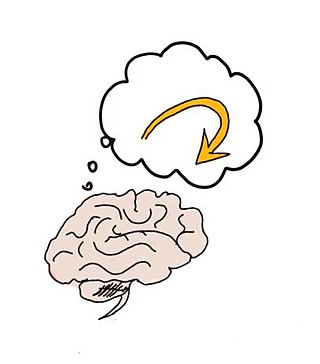Related Research Articles
Operant conditioning, also called instrumental conditioning, is a learning process where voluntary behaviors are modified by association with the addition of reward or aversive stimuli. The frequency or duration of the behavior may increase through reinforcement or decrease through punishment or extinction.

Learning is the process of acquiring new understanding, knowledge, behaviors, skills, values, attitudes, and preferences. The ability to learn is possessed by humans, non-human animals, and some machines; there is also evidence for some kind of learning in certain plants. Some learning is immediate, induced by a single event, but much skill and knowledge accumulate from repeated experiences. The changes induced by learning often last a lifetime, and it is hard to distinguish learned material that seems to be "lost" from that which cannot be retrieved.

An operant conditioning chamber is a laboratory apparatus used to study animal behavior. The operant conditioning chamber was created by B. F. Skinner while he was a graduate student at Harvard University. The chamber can be used to study both operant conditioning and classical conditioning.

In behavioral psychology, reinforcement refers to consequences that increase the likelihood of an organism's future behavior, typically in the presence of a particular antecedent stimulus. For example, a rat can be trained to push a lever to receive food whenever a light is turned on. In this example, the light is the antecedent stimulus, the lever pushing is the operant behavior, and the food is the reinforcer. Likewise, a student that receives attention and praise when answering a teacher's question will be more likely to answer future questions in class. The teacher's question is the antecedent, the student's response is the behavior, and the praise and attention are the reinforcements.

In social psychology, the fundamental attribution error (FAE) is a cognitive attribution bias in which observers underemphasize situational and environmental factors for the behavior of an actor while overemphasizing dispositional or personality factors. In other words, observers tend to overattribute the behaviors of others to their personality (e.g., he is late because he's selfish) and underattribute them to the situation or context (e.g., he is late because he got stuck in traffic). Although personality traits and predispositions are considered to be observable facts in psychology, the fundamental attribution error is an error because it misinterprets their effects.
Social learning theory is a theory of social behavior that proposes that new behaviors can be acquired by observing and imitating others. It states that learning is a cognitive process that takes place in a social context and can occur purely through observation or direct instruction, even in the absence of motor reproduction or direct reinforcement. In addition to the observation of behavior, learning also occurs through the observation of rewards and punishments, a process known as vicarious reinforcement. When a particular behavior is rewarded regularly, it will most likely persist; conversely, if a particular behavior is constantly punished, it will most likely desist. The theory expands on traditional behavioral theories, in which behavior is governed solely by reinforcements, by placing emphasis on the important roles of various internal processes in the learning individual. Albert Bandura is known for studying this theory.
Language transfer is the application of linguistic features from one language to another by a bilingual or multilingual speaker. Language transfer may occur across both languages in the acquisition of a simultaneous bilingual, from a mature speaker's first language (L1) to a second language (L2) they are acquiring, or from an L2 back to the L1. Language transfer is most commonly discussed in the context of English language learning and teaching, but it can occur in any situation when someone does not have a native-level command of a language, as when translating into a second language. Language transfer is also a common topic in bilingual child language acquisition as it occurs frequently in bilingual children especially when one language is dominant.

Metacognition is an awareness of one's thought processes and an understanding of the patterns behind them. The term comes from the root word meta, meaning "beyond", or "on top of". Metacognition can take many forms, such as reflecting on one's ways of thinking, and knowing when and how oneself and others use particular strategies for problem-solving. There are generally two components of metacognition: (1) cognitive conceptions and (2) cognitive regulation system. Research has shown that both components of metacognition play key roles in metaconceptual knowledge and learning. Metamemory, defined as knowing about memory and mnemonic strategies, is an important aspect of metacognition.
Transfer of training is applying knowledge and skills acquired during training to a targeted job or role. This is a term commonly used within industrial and organizational psychology.
Memory has the ability to encode, store and recall information. Memories give an organism the capability to learn and adapt from previous experiences as well as build relationships. Encoding allows a perceived item of use or interest to be converted into a construct that can be stored within the brain and recalled later from long-term memory. Working memory stores information for immediate use or manipulation, which is aided through hooking onto previously archived items already present in the long-term memory of an individual.
Social cognitive theory (SCT), used in psychology, education, and communication, holds that portions of an individual's knowledge acquisition can be directly related to observing others within the context of social interactions, experiences, and outside media influences. This theory was advanced by Albert Bandura as an extension of his social learning theory. The theory states that when people observe a model performing a behavior and the consequences of that behavior, they remember the sequence of events and use this information to guide subsequent behaviors. Observing a model can also prompt the viewer to engage in behavior they already learned. Depending on whether people are rewarded or punished for their behavior and the outcome of the behavior, the observer may choose to replicate behavior modeled. Media provides models for a vast array of people in many different environmental settings.
Punishment is any change in a human or animal's surroundings which, occurring after a given behavior or response, reduces the likelihood of that behavior occurring again in the future. Reinforcement, referring to any behavior that increases the likelihood that a response will occurs, plays a large role in punishment. Motivating operations (MO) can be categorized in abolishing operations, decrease the effectiveness of the stimuli and establishing, increase the effectiveness of the stimuli. For example, a painful stimulus which would act as a punisher for most people may actually reinforce some behaviors of masochistic individuals.
Einstellung is the development of a mechanized state of mind. Often called a problem solving set, Einstellung refers to a person's predisposition to solve a given problem in a specific manner even though better or more appropriate methods of solving the problem exist.

In psychology, negative affectivity (NA), or negative affect, is a personality variable that involves the experience of negative emotions and poor self-concept. Negative affectivity subsumes a variety of negative emotions, including anger, contempt, disgust, guilt, fear, and nervousness. Low negative affectivity is characterized by frequent states of calmness and serenity, along with states of confidence, activeness, and great enthusiasm.
Indirect memory tests assess the retention of information without direct reference to the source of information. Participants are given tasks designed to elicit knowledge that was acquired incidentally or unconsciously and is evident when performance shows greater inclination towards items initially presented than new items. Performance on indirect tests may reflect contributions of implicit memory, the effects of priming, a preference to respond to previously experienced stimuli over novel stimuli. Types of indirect memory tests include the implicit association test, the lexical decision task, the word stem completion task, artificial grammar learning, word fragment completion, and the serial reaction time task.
Psychological behaviorism is a form of behaviorism—a major theory within psychology which holds that generally human behaviors are learned—proposed by Arthur W. Staats. The theory is constructed to advance from basic animal learning principles to deal with all types of human behavior, including personality, culture, and human evolution. Behaviorism was first developed by John B. Watson (1912), who coined the term "behaviorism", and then B. F. Skinner who developed what is known as "radical behaviorism". Watson and Skinner rejected the idea that psychological data could be obtained through introspection or by an attempt to describe consciousness; all psychological data, in their view, was to be derived from the observation of outward behavior. The strategy of these behaviorists was that the animal learning principles should then be used to explain human behavior. Thus, their behaviorisms were based upon research with animals.
Attributional ambiguity is a psychological attribution concept describing the difficulty that members of stigmatized or negatively stereotyped groups may have in interpreting feedback. According to this concept, a person who perceives themselves as stigmatized can attribute negative feedback to prejudice. This can lead stigmatized group members to feel uncertainty about whether negative outcomes are due to discrimination against them or their own behavior. In comparison, they might discredit positive feedback as a form of sympathy rather than seeing it as the result of their ability and achievement. The term was coined by Melvin Snyder, Robert E. Kleck, Angelo Strenta, and Steven J. Mentzer in 1979 before being popularized by Jennifer Crocker, Brenda Major and their colleagues in the 1990s.
In psychology of art, the relationship between art and emotion has newly been the subject of extensive study thanks to the intervention of esteemed art historian Alexander Nemerov. Emotional or aesthetic responses to art have previously been viewed as basic stimulus response, but new theories and research have suggested that these experiences are more complex and able to be studied experimentally. Emotional responses are often regarded as the keystone to experiencing art, and the creation of an emotional experience has been argued as the purpose of artistic expression. Research has shown that the neurological underpinnings of perceiving art differ from those used in standard object recognition. Instead, brain regions involved in the experience of emotion and goal setting show activation when viewing art.
Generalization is the concept that humans, other animals, and artificial neural networks use past learning in present situations of learning if the conditions in the situations are regarded as similar. The learner uses generalized patterns, principles, and other similarities between past experiences and novel experiences to more efficiently navigate the world. For example, if a person has learned in the past that every time they eat an apple, their throat becomes itchy and swollen, they might assume they are allergic to all fruit. When this person is offered a banana to eat, they reject it upon assuming they are also allergic to it through generalizing that all fruits cause the same reaction. Although this generalization about being allergic to all fruit based on experiences with one fruit could be correct in some cases, it may not be correct in all. Both positive and negative effects have been shown in education through learned generalization and its contrasting notion of discrimination learning.
Stress exposure training is the practicing of important existing skills in a stressful and distracting environment to develop the ability to perform them reliably in spite of the circumstances.
References
- ↑ Luchins & Luchins (1970) How People Learn, pp. 53–54.
- 1 2 Woltz, D. J., Gardner, M. K., & Bell, B. G. (2000). "Negative transfer errors in sequential cognitive skills: Strong-but-wrong sequence application". Journal of Experimental Psychology: Learning, Memory, and Cognition, 26(3), 601-635.
- ↑ Leo Postman; Karen Stark (January 1969). "Role of response availability in transfer and interference" (PDF). Journal of Experimental Psychology . 79 (1): 168–177. doi:10.1037/h0026932. Archived from the original (PDF) on 2014-10-06.
- ↑ Osman, Magda (2005) Positive transfer and Negative transfer/Anti-Learning of Problem Solving Skills p. 40.
- ↑ Bandura, A., & Locke, E. A. (2003). "Negative self-efficacy and goal effects revisited". Journal of Applied Psychology , 88, 87-99.
- ↑ Perkins, David & Salomon, Gavriel (1992) "Transfer of Learning", International Encyclopedia of Education